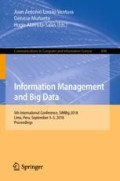Abstract
Authorship verification is the task of determining whether a specific individual did or did not write a text, which very naturally can be reduced to the binary-classification problem. This paper deals with the authorship verification of short email messages. Hereafter, we use “message” to identify the content of the information that is transmitted by email. The proposed method implements the binary classification with a sequence-to-sequence (seq2seq) model and trains a convolutional neural network (CNN) on positive (written by the “target” user) and negative (written by “someone else”) examples. The proposed method differs from previously published works, which represent text by numerous stylometric features, by requiring neither advanced text preprocessing nor explicit feature extraction. All messages are submitted to the CNN “as is,” after padding to the maximal length and replacing all words by their ID numbers. CNN learns the most appropriate features with backpropagation and then performs classification. The experiments performed on the Enron dataset using the TensorFlow framework show that the CNN classifier verifies message authorship very accurately.
Access this chapter
Tax calculation will be finalised at checkout
Purchases are for personal use only
Notes
- 1.
- 2.
We kept the default settings of the CNN model in the TensorFlow framework, which are as follows: number of embedding dimensions is 128; filter sizes are 3, 4, and 5; number of filters is 128, dropout probability is 0.5, L2 regularization lambda is 0, batch size is 64.
- 3.
The best accuracy of \(89\%\) for 40 users from the Enron dataset was reported in [5].
- 4.
We ran our model with 500 epochs.
- 5.
Obtained from training on one of the users.
References
Abadi, M., et al.: Tensorflow: a system for large-scale machine learning. In: Proceedings of the 12th USENIX Conference on Operating Systems Design and Implementation OSDI 2016, pp. 265–283. USENIX Association, Berkeley (2016). http://dl.acm.org/citation.cfm?id=3026877.3026899
Britz, D.: Understanding convolutional neural networks for NLP (2015)
Brocardo, M.L., Traore, I., Woungang, I.: Authorship verification of e-mail and tweet messages applied for continuous authentication. J. Comput. Syst. Sci. 81(8), 1429–1440 (2015)
Brocardo, M.L., Traore, I., Woungang, I., Obaidat, M.S.: Authorship verification using deep belief network systems. Int. J. Commun. Syst. 30(12), e3259 (2017)
Chen, X., Hao, P., Chandramouli, R., Subbalakshmi, K.P.: Authorship similarity detection from email messages. In: Perner, P. (ed.) MLDM 2011. LNCS (LNAI), vol. 6871, pp. 375–386. Springer, Heidelberg (2011). https://doi.org/10.1007/978-3-642-23199-5_28
Collobert, R., Weston, J., Bottou, L., Karlen, M., Kavukcuoglu, K., Kuksa, P.: Natural language processing (almost) from scratch. J. Mach. Learn. Res. 12(Aug), 2493–2537 (2011)
Desmedt, Y.: Man-in-the-middle attack. In: van Tilborg, H.C.A. (ed.) Encyclopedia of Cryptography and Security. Springer, Boston (2005). https://doi.org/10.1007/0-387-23483-7
El Bouanani, S.E.M., Kassou, I.: Authorship analysis studies: a survey. Int. J. Comput. Appl. (0975 – 8887) 86(12), 22–29 (2014)
Iqbal, F., Khan, L.A., Fung, B., Debbabi, M.: E-mail authorship verification for forensic investigation. In: Proceedings of the 2010 ACM Symposium on Applied Computing, pp. 1591–1598. ACM (2010)
Kim, Y.: Convolutional neural networks for sentence classification. In: Proceedings of the 2014 Conference on Empirical Methods in Natural Language Processing (EMNLP), pp. 1746–1751 (2014)
Kipf, T.N., Welling, M.: Semi-supervised classification with graph convolutional networks. In: 2017 Proceedings of ICLR (2017)
Klimt, B., Yang, Y.: The enron corpus: a new dataset for email classification research. In: Boulicaut, J.-F., Esposito, F., Giannotti, F., Pedreschi, D. (eds.) ECML 2004. LNCS (LNAI), vol. 3201, pp. 217–226. Springer, Heidelberg (2004). https://doi.org/10.1007/978-3-540-30115-8_22
Koppel, M., Schler, J.: Authorship verification as a one-class classification problem. In: Proceedings of the Twenty-First International Conference on Machine learning, p. 62. ACM (2004)
Li, J.S., Chen, L.C., Monaco, J.V., Singh, P., Tappert, C.C.: A comparison of classifiers and features for authorship authentication of social networking messages. Concurr. Comput.: Pract. Exp. 29(14), e3918 (2017)
Mikolov, T., Sutskever, I., Chen, K., Corrado, G.S., Dean, J.: Distributed representations of words and phrases and their compositionality. In: Advances in Neural Information Processing Systems, pp. 3111–3119 (2013)
Nirkhi, S.M., Dharaskar, R., Thakare, V.: Authorship identification using generalized features and analysis of computational method. Trans. Mach. Learn. Artif. Intell. 3(2), 41 (2015)
Pennington, J., Socher, R., Manning, C.: Glove: global vectors for word representation. In: Proceedings of the 2014 Conference on Empirical Methods in Natural Language Processing (EMNLP), pp. 1532–1543 (2014)
Polychronakis, M., Provos, N.: Ghost turns zombie: exploring the life cycle of web-based malware. LEET 8, 1–8 (2008)
Zhang, Y., Wallace, B.: A sensitivity analysis of (and practitioners’ guide to) convolutional neural networks for sentence classification. arXiv preprint arXiv:1510.03820 (2015)
Acknowledgments
The author is grateful to Vlad Vavilin and Mark Mishaev for the implementation and running the experiments using the TensorFlow framework.
Author information
Authors and Affiliations
Corresponding author
Editor information
Editors and Affiliations
Rights and permissions
Copyright information
© 2019 Springer Nature Switzerland AG
About this paper
Cite this paper
Litvak, M. (2019). Deep Dive into Authorship Verification of Email Messages with Convolutional Neural Network. In: Lossio-Ventura, J., Muñante, D., Alatrista-Salas, H. (eds) Information Management and Big Data. SIMBig 2018. Communications in Computer and Information Science, vol 898. Springer, Cham. https://doi.org/10.1007/978-3-030-11680-4_14
Download citation
DOI: https://doi.org/10.1007/978-3-030-11680-4_14
Published:
Publisher Name: Springer, Cham
Print ISBN: 978-3-030-11679-8
Online ISBN: 978-3-030-11680-4
eBook Packages: Computer ScienceComputer Science (R0)

